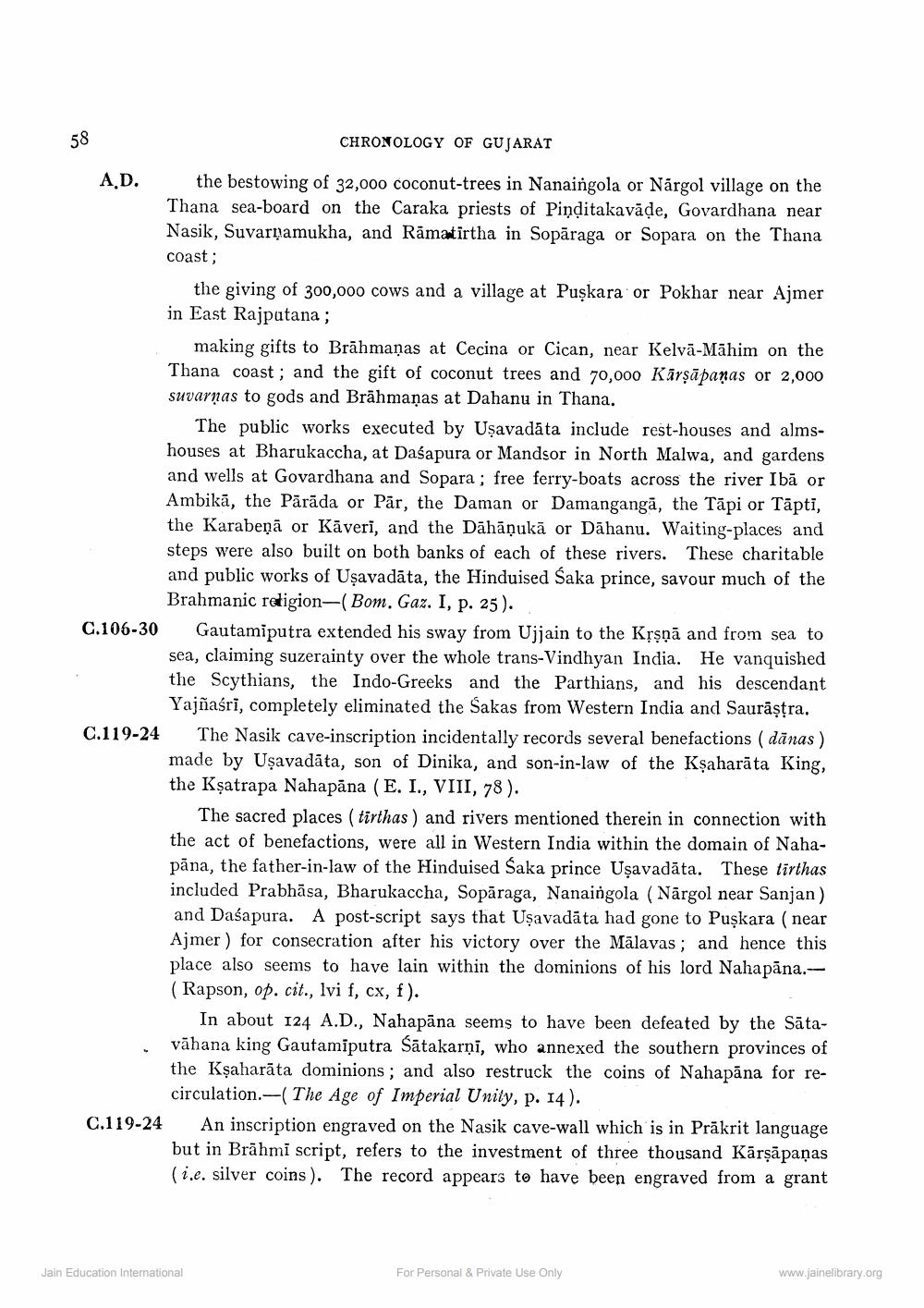________________
CHRONOLOGY OF GUJARAT
A.D. the bestowing of 32,000 coconut-trees in Nanaingola or Nārgol village on the
Thana sea-board on the Caraka priests of Pinditakavāde, Govardhana near Nasik, Suvarņamukha, and Rāmatirtha in Sopāraga or Sopara on the Thana coast;
the giving of 300,000 cows and a village at Puskara or Pokhar near Ajmer in East Rajputana;
making gifts to Brāhmaṇas at Cecina or Cican, near Kelvā-Māhim on the Thana coast; and the gift of coconut trees and 70,000 Kārşāpaņas or 2,000 suvarnas to gods and Brāhmaṇas at Dahanu in Thana.
The public works executed by Uşavadāta include rest-houses and almshouses at Bharukaccha, at Dasapura or Mandsor in North Malwa, and gardens and wells at Govardhana and Sopara ; free ferry-boats across the river Ibā or Ambikā, the Pārāda or Pār, the Daman or Damangangā, the Tāpi or Tāpti, the Karabeņā or Kāveri, and the Dāhāṇukā or Dāhanu. Waiting-places and steps were also built on both banks of each of these rivers. These charitable and public works of Uşavadāta, the Hinduised Śaka prince, savour much of the
Brahmanic redigion-(Bom. Gaz. I, p. 25). C.106-30 Gautamiputra extended his sway from Ujjain to the Krsņā and from sea to
sea, claiming suzerainty over the whole trans-Vindhyan India. He vanquished the Scythians, the Indo-Greeks and the Parthians, and his descendant
Yajñaśri, completely eliminated the Sakas from Western India and Saurāṣtra. C.119-24 The Nasik cave-inscription incidentally records several benefactions ( dānas )
made by Uşavadāta, son of Dinika, and son-in-law of the Kşaharāta King, the Ksatrapa Nahapāna (E. I., VIII, 78).
The sacred places ( tirthas ) and rivers mentioned therein in connection with the act of benefactions, were all in Western India within the domain of Nahapāna, the father-in-law of the Hinduised Saka prince Uşavadāta. These tirthas included Prabhāsa, Bharukaccha, Sopāraga, Nanaingola (Nārgol near Sanjan) and Daśapura. A post-script says that Uşavadāta had gone to Puşkara (near Ajmer) for consecration after his victory over the Mālavas; and hence this place also seems to have lain within the dominions of his lord Nahapāna.(Rapson, op. cit., lvi f, cx, f).
In about 124 A.D., Nahapāna seems to have been defeated by the Sātavāhana king Gautamiputra Šātakarni, who annexed the southern provinces of the Kşaharāta dominions; and also restruck the coins of Nahapāna for re
circulation.--(The Age of Imperial Unity, p. 14). C.119-24 An inscription engraved on the Nasik cave-wall which is in Prākrit language
but in Brāhmi script, refers to the investment of three thousand Kārşāpaņas (i.e. silver coins). The record appears to have been engraved from a grant
Jain Education International
For Personal & Private Use Only
www.jainelibrary.org




